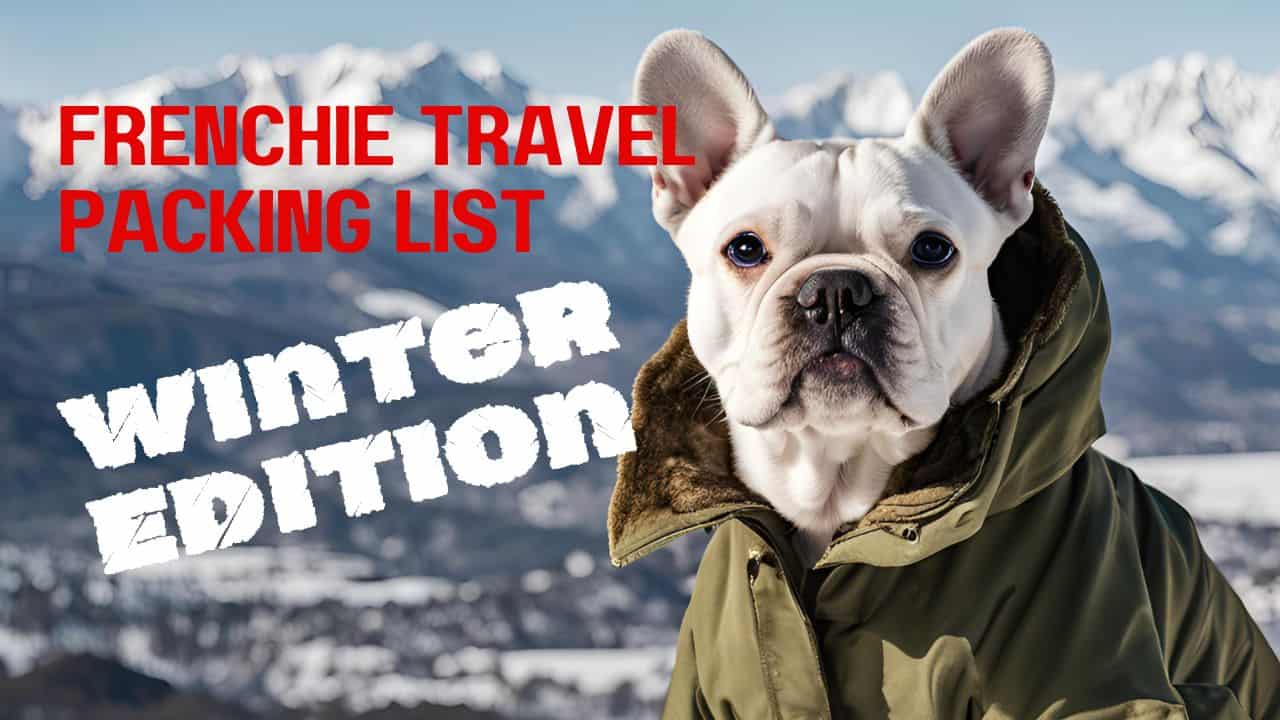Traveling with a frenchie takes planning. I’ve successfully traveled across the US and Europe with my frenchie Helga – from Northern Alaska to the South of Italy and from the Alps to the Canary Islands, in winter and summer. It can be done safely, but you definitely need to prepare.
As the author of a survival and preparedness guide for humans and their pets, I’m always thinking about and planning for the needs and safety of my dog in unpredictable environments. My frenchie has taught me a lot about how to navigate both local, domestic, and international trips, and I’m happy to share my best advice and strategies for successful cold weather travel with you and your frenchie! And will traveling with your frenchie be worth it? Definitely!
The Adventure Lion contains affiliate links and is a member of the Amazon Services LLC Associates Program. If you make a purchase using one of these Amazon links, we will receive a small amount of compensation at no extra cost to you.
Winter Traveling with a Frenchie and Other Snub-Nosed Breeds
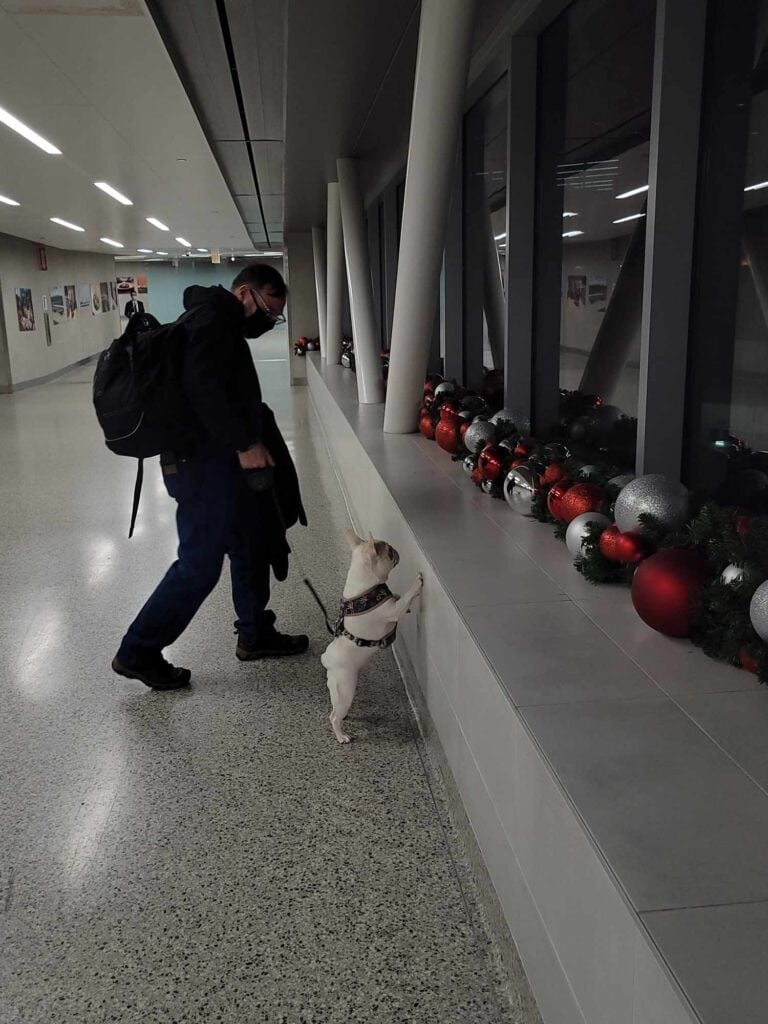
It’s well-known that summertime travel and hot temperatures pose overheating risks for short-nosed breeds like french bulldogs (see our frenchie summer travel list here). But cold temperatures and wintertime travel can also pose challenges.
Which Dogs are Affected Most by Cold Temperatures?
All small dogs, dogs with short or thin hair, puppies, dogs with low body fat, elder dogs, and dogs with underlying medical conditions all need special considerations when exposed to cold. That describes a lot of frenchies, but we should always think of our dogs, no matter their breed, when weather conditions are extreme.
What Conditions Make it Worse?
Some conditions can take a situation where the cold isn’t really that bad, and make it a lot worse, and even a risk for hypothermia which occurs when your dog’s body temperature drops to 100 degrees F (37.5 C).
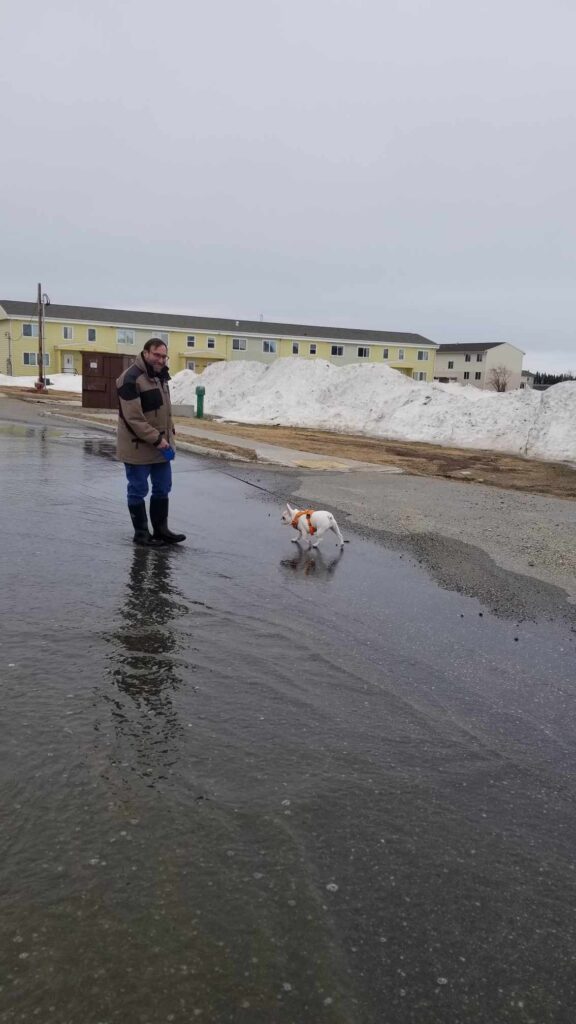
Things can get much more dangerous for your dog if they are wet; if it’s windy; if they are outside for a prolonged period of time; if they have an underlying health problem; and if there is ice, snow, slush, or cold water on the ground.
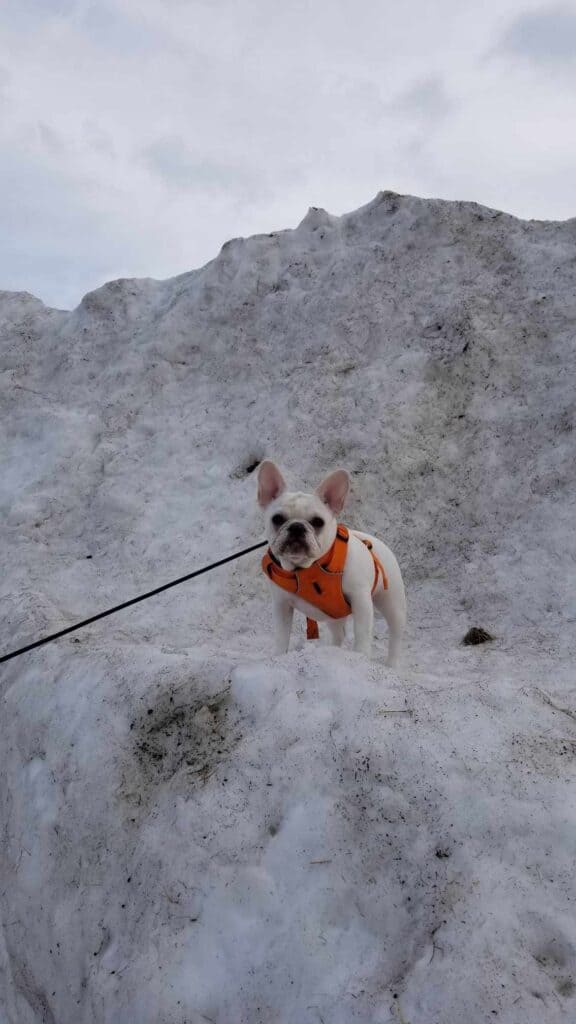

Here are the best tips and tricks for cold weather traveling with a frenchie. Let’s start with the packing list.
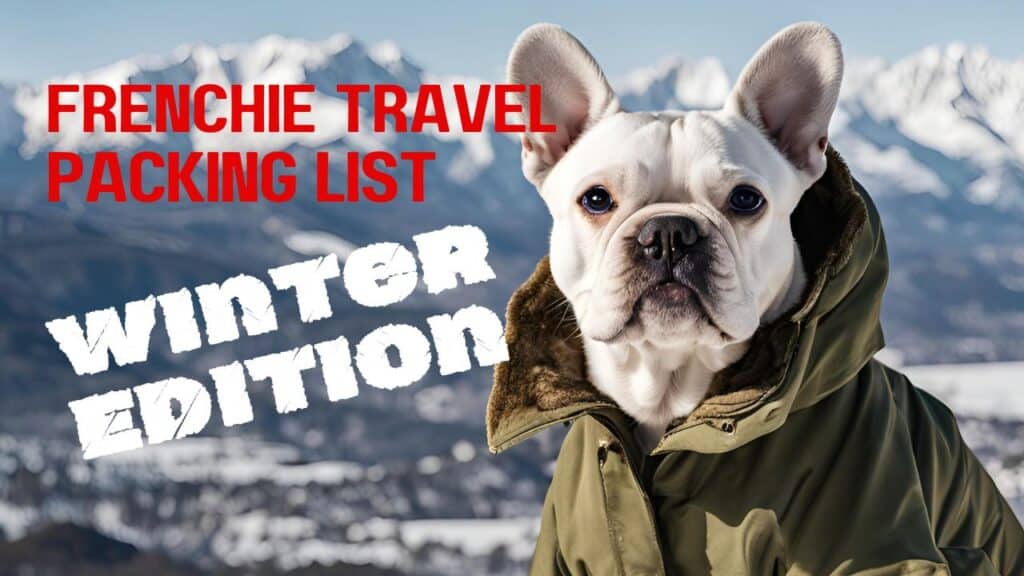
1) Master Packing List for Your Frenchie
Just like you have some essential items you pack for every trip (like a toothbrush, and underwear) your frenchie should have a master packing list for everywhere they travel. After that, take into consideration your destination, and include seasonal items and accessories for cold weather safety.
Food
If at all possible, try to bring your frenchie’s regular food when you travel. Switching food while traveling can cause all kinds of unpleasant issues (iykyk). If you’ll be able to buy their usual food at your destination, that’s great! Just bring an emergency meal or two in case of unanticipated delays or problems.
If you do have to switch up your dog’s food, make the transition slow by blending their regular and new food before you travel. I make Helga’s usual moist food fresh, so it’s not possible to bring it. So when we are on the road, she eats a dehydrated raw food because it’s lightweight and easy to pack. I won’t recommend a specific food since frenchies are all so different in terms of what they like and can tolerate. You know your frenchie best!
If your frenchie is going to be out in the elements when it’s chilly, they will burn more calories than usual because it takes energy to stay warm. So you’ll want to give them a little extra. I guarantee they won’t complain!
For air travel, remember to consider where you should pack their food – checked luggage vs. carry-on. A zealous TSA agent in Frankfurt almost stole Helga’s emergency package of beef stew one time! Now it goes in the checked bag.
Bowls
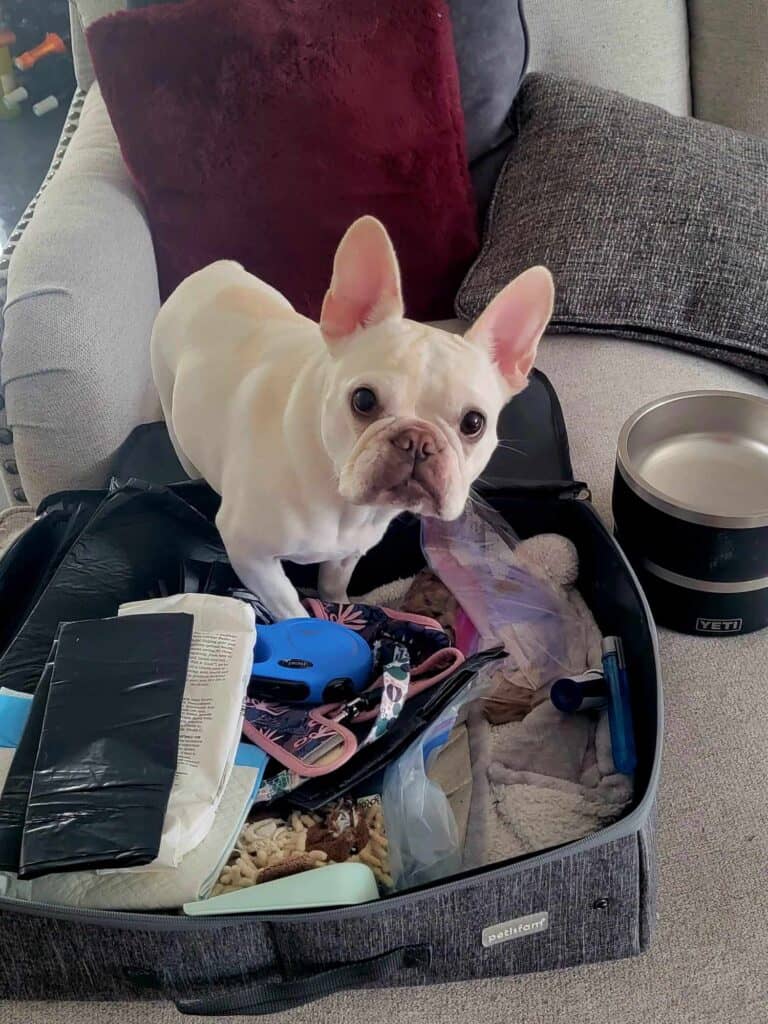
If we’re going on a trip by car or camper where I have lots of room to pack, I love these Yeti dog bowls. They are very solid and heavy, they don’t get accidentally kicked over, have hygienic stainless steel insides, and are dishwasher safe. If we’re flying, or if space and weight is an issue, you can utilize collapsible silicone bowls. They are food grade, pack flat, are light weight, and come with carabiners attached so you can clip them right on to a carrier or leash. Or you can just use disposable paper bowls.
Toys
When Helga sees me packing my suitcase she’s usually right there to make sure we don’t forget her toy! Be sure it’s something comforting and fun that isn’t a choking hazard (that includes squeakers, plastic bits, and fluff inside the toy).
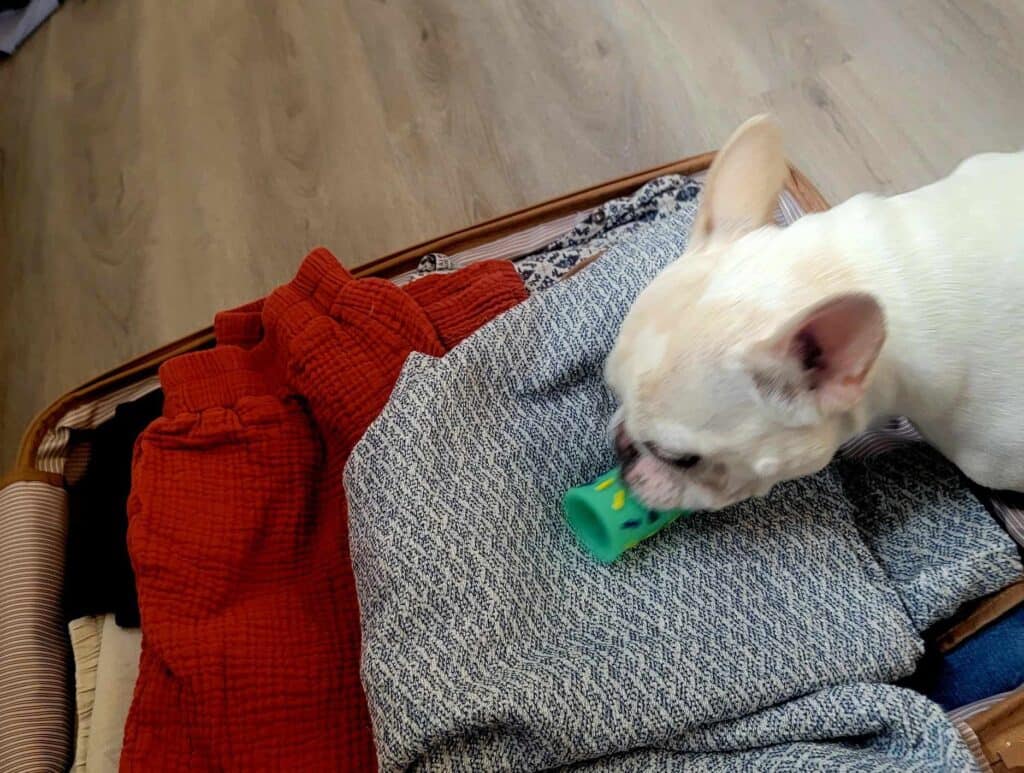
Every frenchie is different, but here are some of Helga’s favorite travel toys.
The beloved armadillo (she’s gutted several of these but still loves the destuffed shell), the Nylabone textured power chew (incredibly she’s still on her first!), the indestructible rubber cheeseburger (she found this on a hiking trail in Alaska and carried it the whole way back!), the Kong Wubba which is a great tug toy, the grunting latex pig which I’m pretty sure she thinks is her baby (here’s a similar grunting pig), and the ever-popular licky mat (you can use Kong filling or peanut butter).
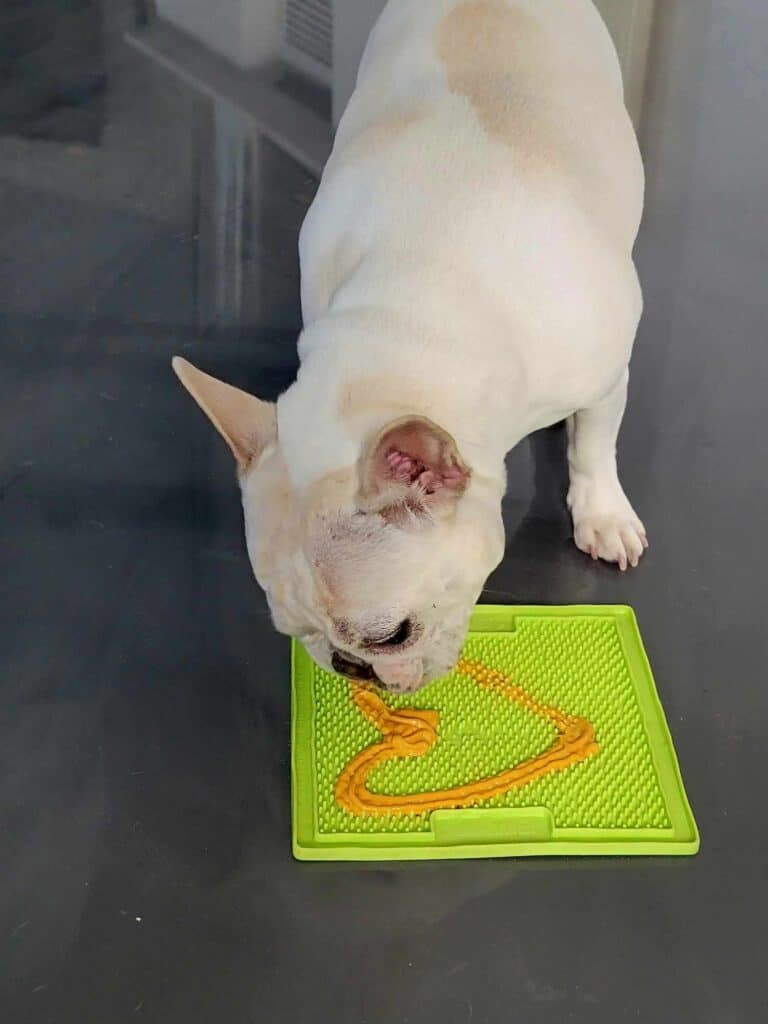



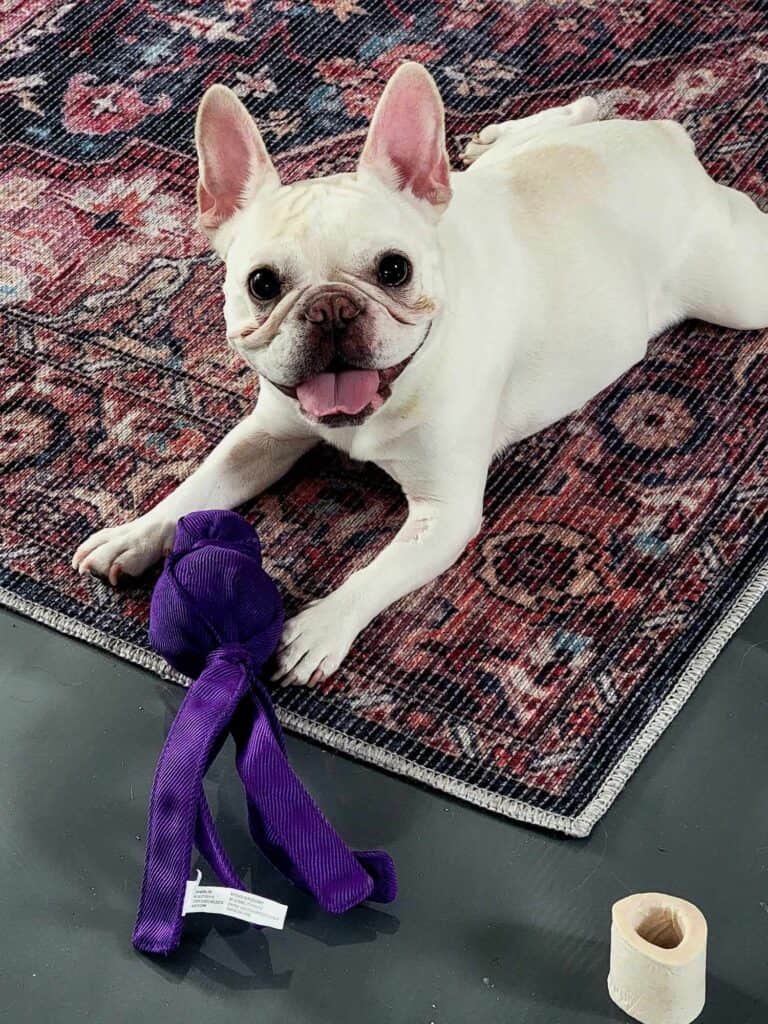
Favorite Treats
Frenchies are incredibly food-motivated creatures, so always bring a bag of little training treats for use on the plane, at the airport, during a long car trip, or anytime they’ve been a very good boy or girl!
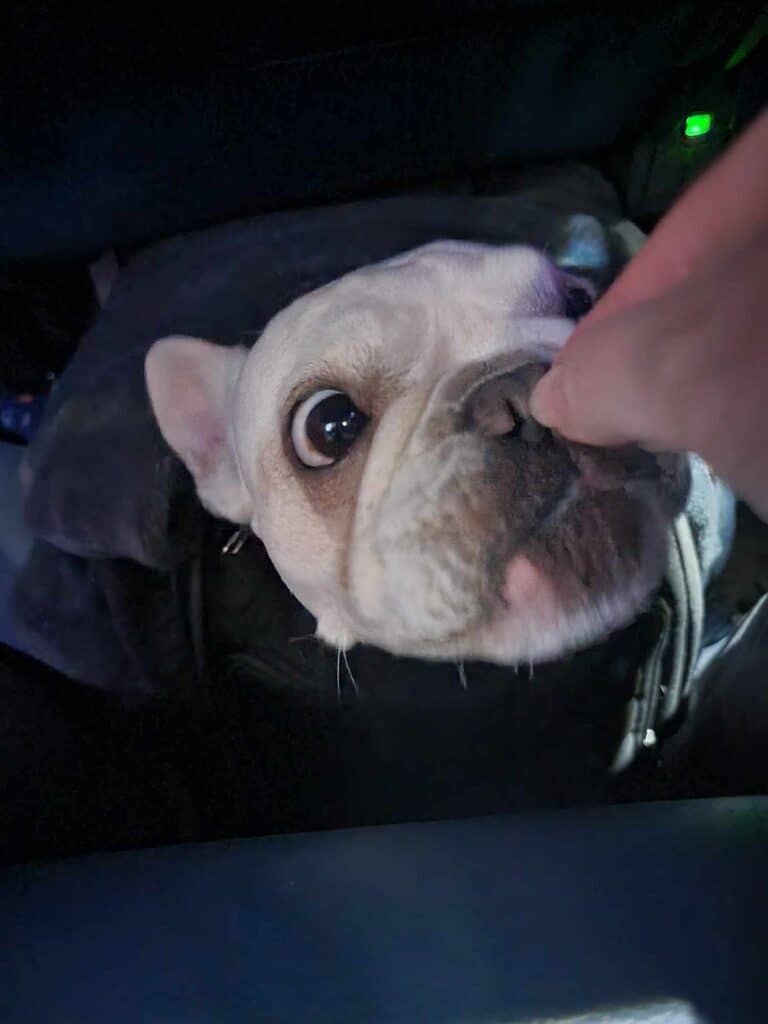
As an Alaska dog, Helga grew up eating salmon skin so she loves these wild salmon training treats!
Bed or Warm Blanket
We’ve take her bed when we road trip or camp, but even when you can’t bring it be sure to have a small cozy blanket or towel that smells like home. When space allows, Helga loves this super-comfy warm fuzzy bed.

Leash and Harness
Frenchies have a comparatively large chest to waist ratio, and I’ve found that Lucy & Co.’s adjustable harnesses work great for Helga. They are also super cute. They have a lot of fall, winter and holiday-themed patterns, and are also reversible so it’s like getting two harnesses in one!
For hiking, camping, and outdoor recreation we use something a little tougher. We’ve found that the Ruffwear harness in orange below really stands up to wear. She’s been hiking and camping with the same one for almost five years and it’s holding strong. I can’t recommend it enough!
I should also mention that harnesses are much safer than collars for attaching a leash. Frenchie’s are vulnerable to neck and spinal injuries, and harnesses put the stress on the chest and not the neck.
I also use a locking retractable leash for traveling which is small and doesn’t get tangled It also fits in the pocket of her airline carrier.
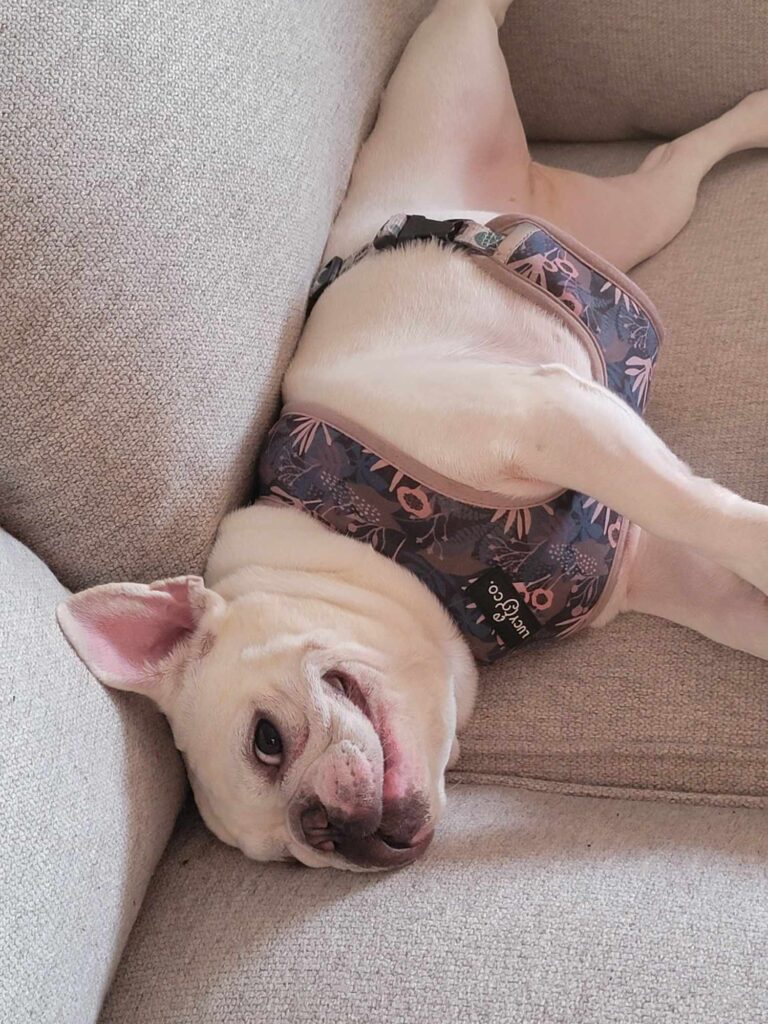
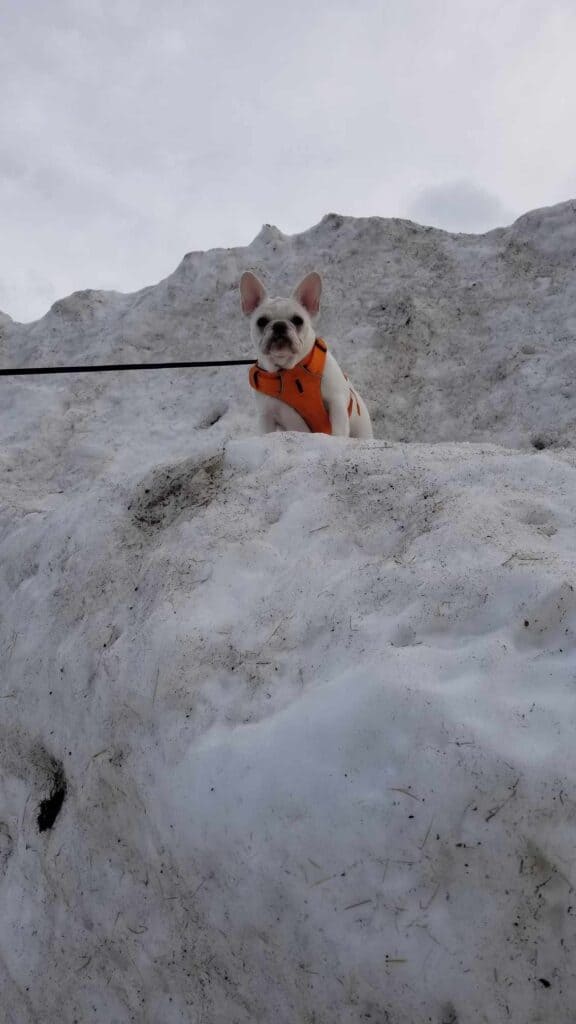
Documentation
If you are traveling to another state or country, be sure to research your destination’s rules and regulations for shots and medical treatments long before you travel. Pay close attention to any timeline requirements you need to follow for vaccinations, physical exams, or other treatments. During your travels you may be asked to show a copy of your dog’s shot records, a European pet passport, a record of tapeworm treatment, proof that they are microchipped, or a report of physical exam signed by a vet, just to name a few.
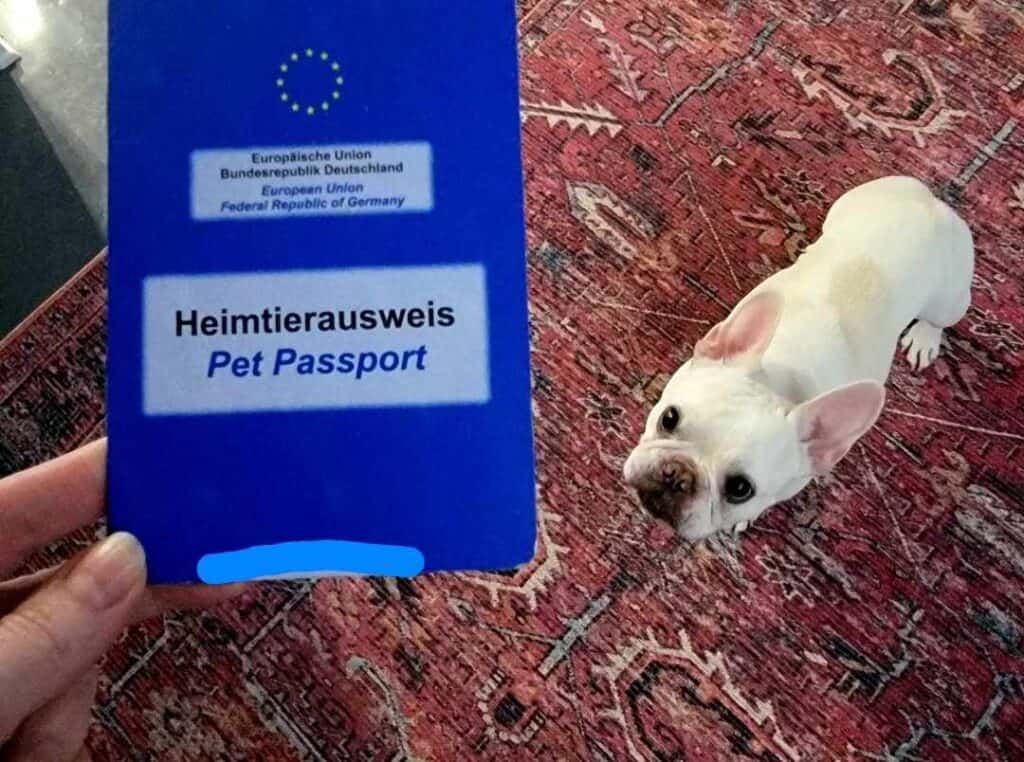
Identification tags and Microchips
Be sure that your dog’s tags show your current address and phone number! Also if your dog has a microchip (which is required for some destinations, and always a good idea), make certain that the chip records are for your current address too.
We also have Helga registered with Tasso since we currently live in Germany. She also has a tag that reads “I’m chipped” with our name, address, and phone number on the other side, so if someone finds her without us, they’ll know what to do.
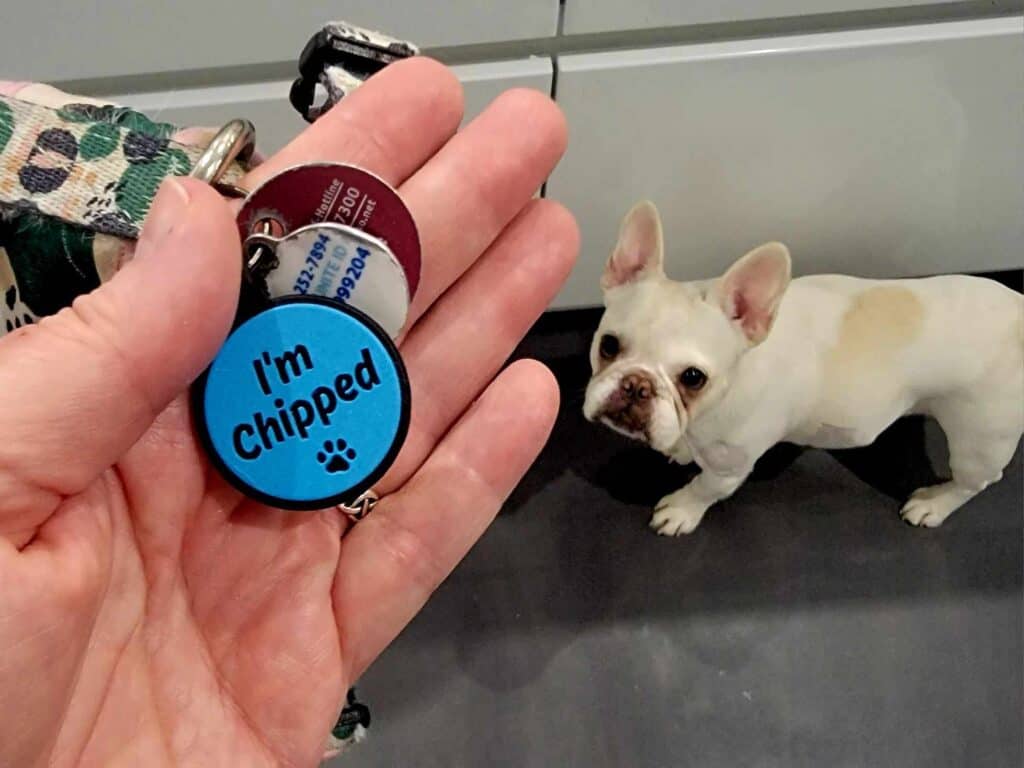
Pee Pads and Poop Bags
Even if your dog doesn’t normally use pee pads, you should use them to line the bottom of their carrier or kennel, and wrap them around the foam insert of the cushion in case of accidents. A loose one is also handy to quickly clean up an accident.
We use these charcoal ones because of the padding, absorbency, and odor control.
I should also mention that Helga uses a litter box (which is really nice for hotel rooms and when the weather is extreme). She was born in Alaska and the litter box came in very handy when the weather dove well below zero, or we had blizzard conditions. For the set-up we use, which includes that litter box, those pee pads, and this tiny dustpan, check out this article about staying in a hotel with your dog.
These are the poop bags we use, and we’ve been really happy with them. They are nice and thick.
Bully Wipes
Frenchies need some help… “back there” on occasion (especially if they are a little stressed from traveling) so bully wipes should definitely be on the list! If the whole pack is too much, you can put what you need in a smaller Ziploc bag. We use these wipes because they are gentle, cruelty-free, and are textured. They work well, and Helga has had no allergy issues with them.
They’re also nice to have for general face wipes, paw wipes, and for spot cleaning.
Meds and Supplements
Don’t forget all prescription meds from your vet, any anti-anxiety meds your dog uses specifically for traveling, and supplements like probiotics, vitamins, etc. that they normally take, so their system stays on an even keel.
Always bring more medication than you think you’ll need in case plans get disrupted. An extra week of meds and supplements is my go-to amount.
2) Travel Carriers for Frenchies
✈️ For Airplanes
Every airline requires an “airline approved carrier,” but depending on the airline this can vary slightly, so double-check your particular airline’s requirements. Also, read my post on the best tips and how-to’s for in-cabin airline travel with your dog.
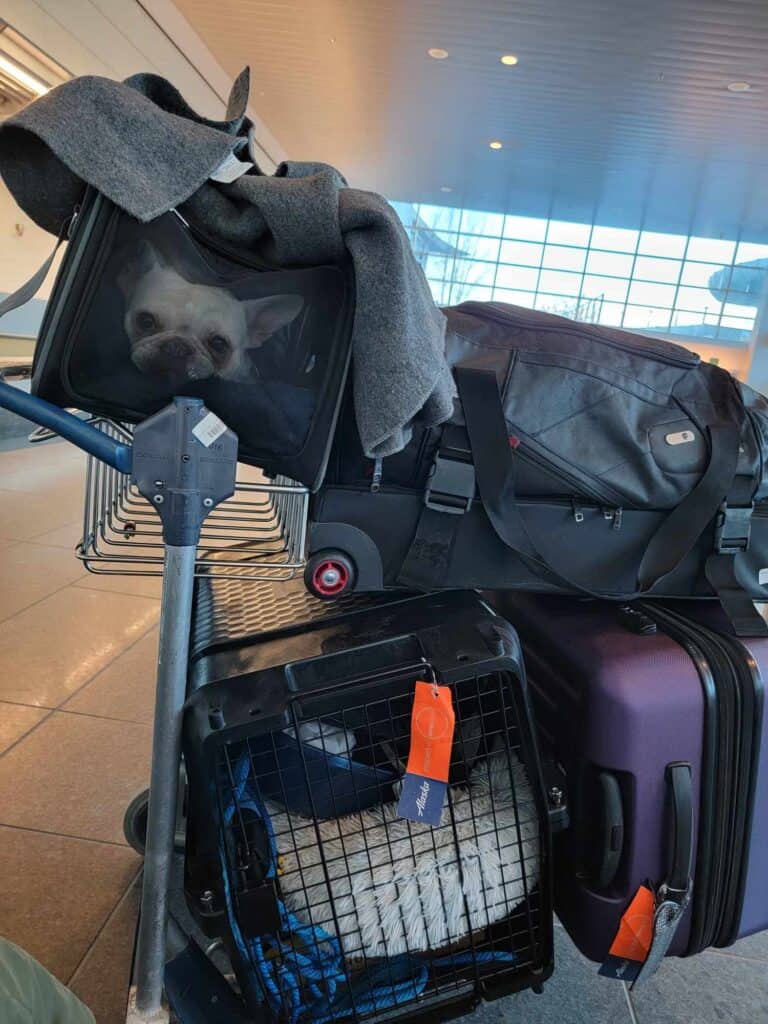
The key to choosing a carrier is ventilation. Make sure the carrier is soft-sided with at least three mesh sides for easier air flow which is a requirement of most airlines anyway. It also must fit underneath the seat in front of you. Some airline carriers like the one we use for Helga, zip open like a tent to provide extra stretch-out space and air flow while you’re waiting at the gate, and after you get settled in your seat. Even though the weather may be cold outside, frenchies overheat easily so be sure they get lots of air.
We also recommend this lightweight, well-ventilated airline approved carrier.
I’m not going to discuss kennels for flying dogs in cargo or as excess baggage here, because frenchies and other short-nosed breeds cannot safely fly as cargo and should always fly in the cabin.
Here are our reviews of some Frenchie-friendly airlines:
- Delta Airlines – No weight limit, but must fit in carrier under the seat. US domestic and international flights
- Alaska Airlines – No weight limit, but must fit in carrier under the seat. US domestic flights
- Southwest Airlines – No weight limit, but must fit in carrier under the seat. US domestic flights
- Volotea Airlines – 10kg (22 pound) weight limit, flights within Europe
And also check out this article for other airlines including private ones to accommodate larger dogs, and great tips and guidelines for flying with your in-cabin dog.
🚗 Travel With Cars
Crates should be roomy, well-ventilated, and sturdy. Also be sure that your frenchie isn’t in direct sunlight, keeping in mind the direction you’ll be driving. Remember again, frenchies are prone to overheating and direct sun can warm a space quickly, even if it isn’t hot outside. Use a sun shade, or something that can keep your dog protected from the sun while not obstructing air flow. If your dog is in the trunk area, be sure to check on them frequently, listen for panting, and adjust the sun shade if they need it.
Also be sure they have a warm blanket for comfort. If they are cold, they may use it to burrow or make a nest, so watch for that too.
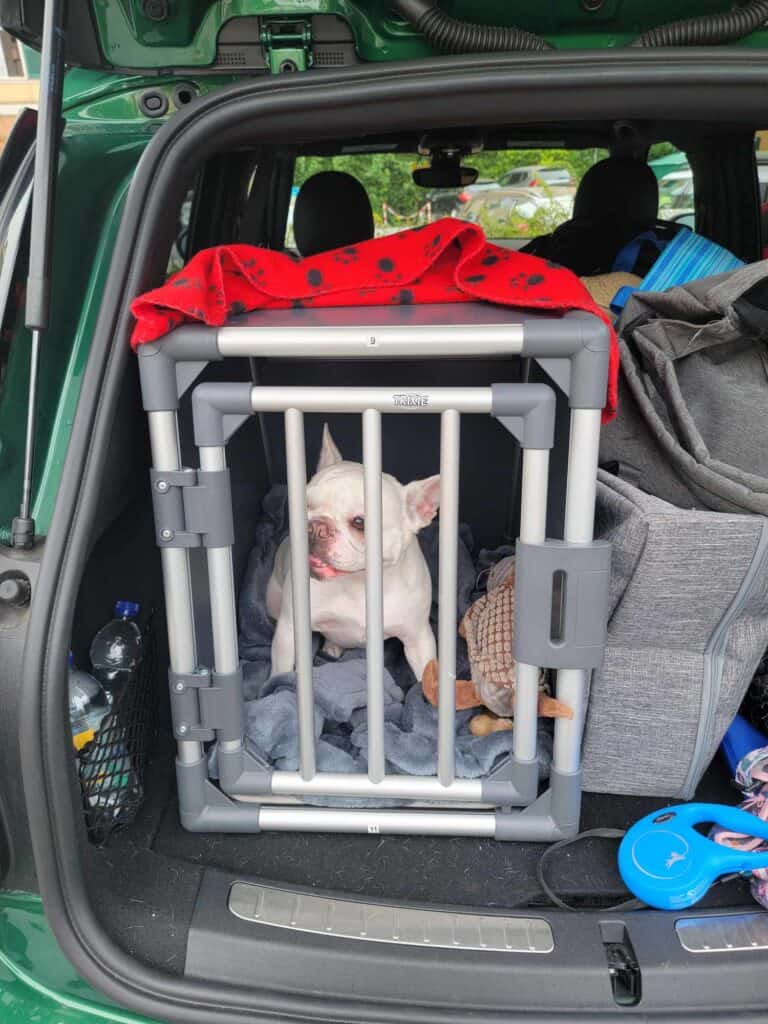
Car seats should be big enough to fit your dog comfortably, attach firmly and safely to the car, and also have a clip to your dog’s harness. Never clip your dog to a collar which can cause injury if you are in an accident or stop short. We used car seats when Helga was a puppy, but now that she’s bigger we have switched to other methods. When you choose a car seat, double check dimensions and make sure it fits your car and your dog!
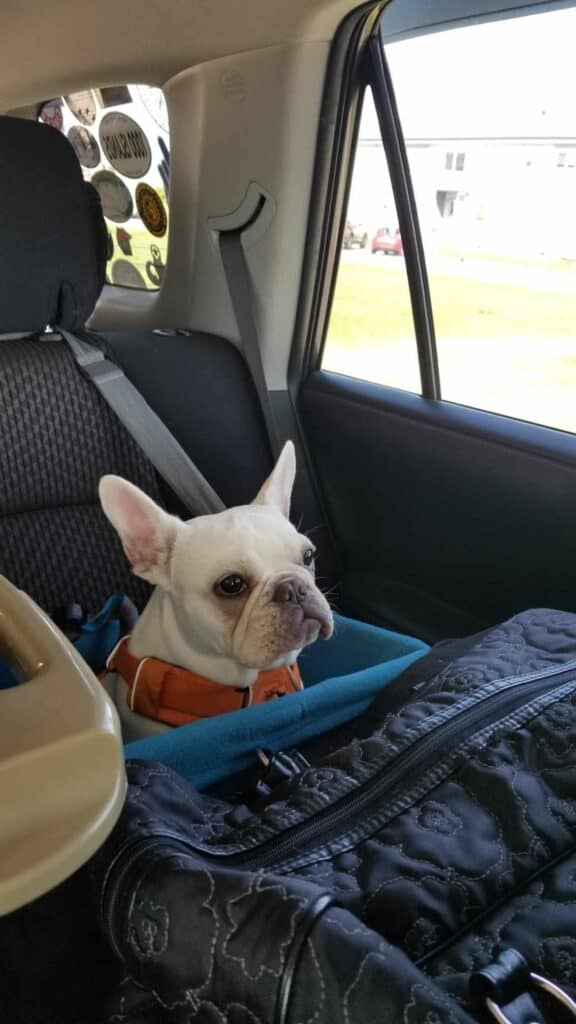
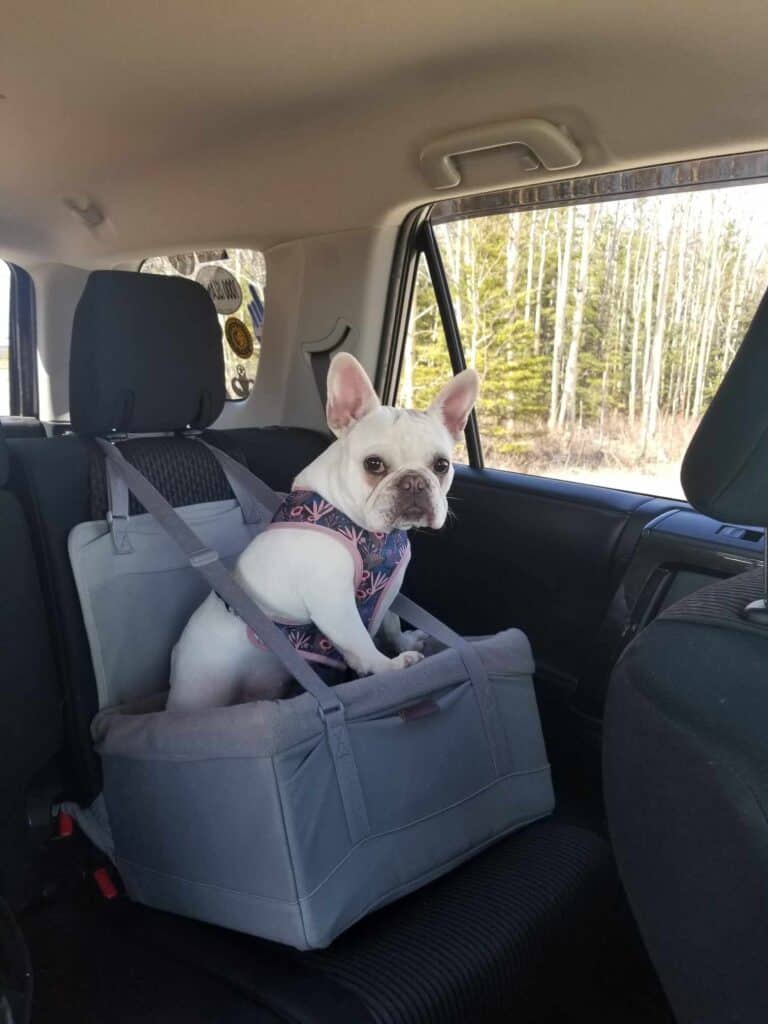
Seatbelt harnesses work well to provide your dog maximum freedom and allow you to keep your eye on how they are doing. Basically they just clip your dogs harness right to the seatbelt. Since Helga outgrew her car seat, we’ve used either a seat belt harness or a sturdy crate depending on our needs. Harnesses keep your dog safe, and keep them from interfering with the driver or becoming a distraction. Make sure they fit well and securely.
🚨NEVER NEVER leave your frenchie (or any dog) in a closed car! Even with windows cracked and temperatures you think are ok, sunlight can turn the inside of your car into a very unsafe space for your frenchie very quickly, and wind and cold can blow inside making it cold fast. Always keep them with you for safety.
🚶♀️For Walking
Helga has an over-the-shoulder bag we like to use sometimes for trains, shuttles, and taxis. She’s a little reactive so this type of bag keeps her physically close and feeling secure, and the thick padded strap makes carrying her much more comfortable than in her bag with handles. It also keeps her close to us and warmer in cool weather.
🥾 For Hiking
Backpacks are becoming more popular for dogs lately, but again frenchies present extra challenges. They are prone to spinal problems (IVFF) which can be very serious, so don’t get backpacks that hold your dog vertically, like you would a child. Go for a ventilated backpack like this one that has a flat bottom so your frenchie can comfortably sit or lie down, and you can expand it for even more room when you set it down. For cool weather hiking, also bring a warm blanket they can burrow under if they need it.
🚉 For Trains, Boats, Shuttle Buses, Taxis, etc.
For most other forms of transportation, your airline travel carrier or the over-shoulder bag will work great. Use whatever works best for your particular situation, and the transportation company’s requirements.
🏞 For ATVs
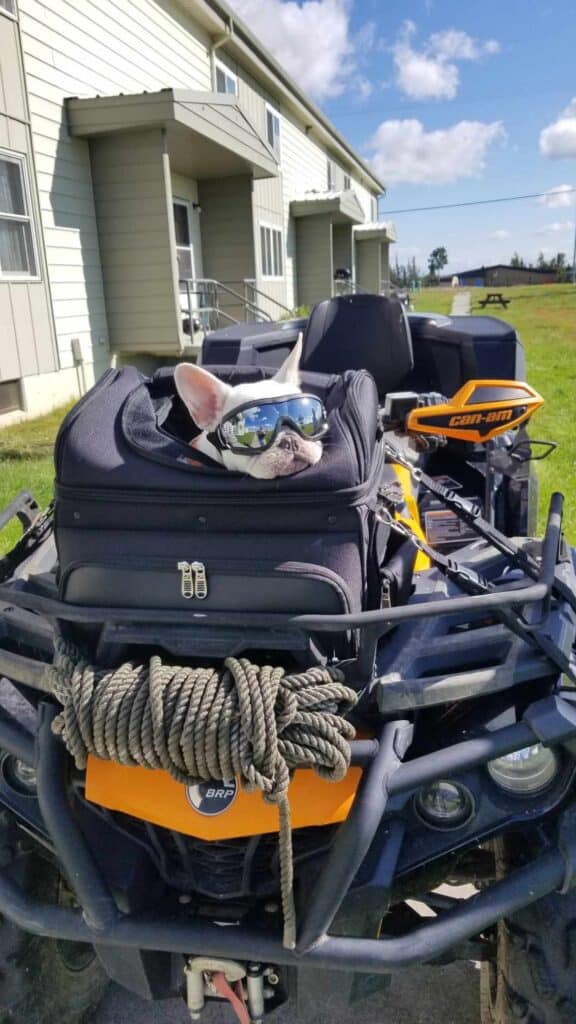
Yep, Helga’s even been ATVing in Alaska! A motorcycle bag was absolutely perfect for our 4-wheeler. We also had snowmachines (snowmobiles) in Alaska, but out of caution for spinal problems, and considering the unintended high-impact moments that often happen on the trail, we did not take Helga out with us. Your frenchie loves adventure, but can’t handle rough rides!
3) Cold Weather Essentials for Traveling with a Frenchie
Be sure you have the proper tools to keep your dog safe and comfortable, no matter the weather!
Warming mats
There are two types of warming mats to consider if your dog gets chilly. This type of warming mat utilizes your dog’s own body heat and retains and reflects it. It doesn’t generate heat on its own but it does work to keep them warm. It’s also very lightweight for travel, and will work in an emergency situation when the lights go out or you are stuck in a car. You may want to use it on top of a bed or cushion if your dog is used to that.
Then there’s the plug-in style of warming mat. These definitely do the job but do depend on having electricity. This heated mat is great because it has an optional timer feature, plenty of heat settings, and a chew-resistant (not chew *proof*) cord. If you’ve got a chewer, always keep your eye on them!
Space Heaters
If your frenchie is a hard-core heat monster like Helga, and if you have room, a small space heater will also do the job while warming the whole room!
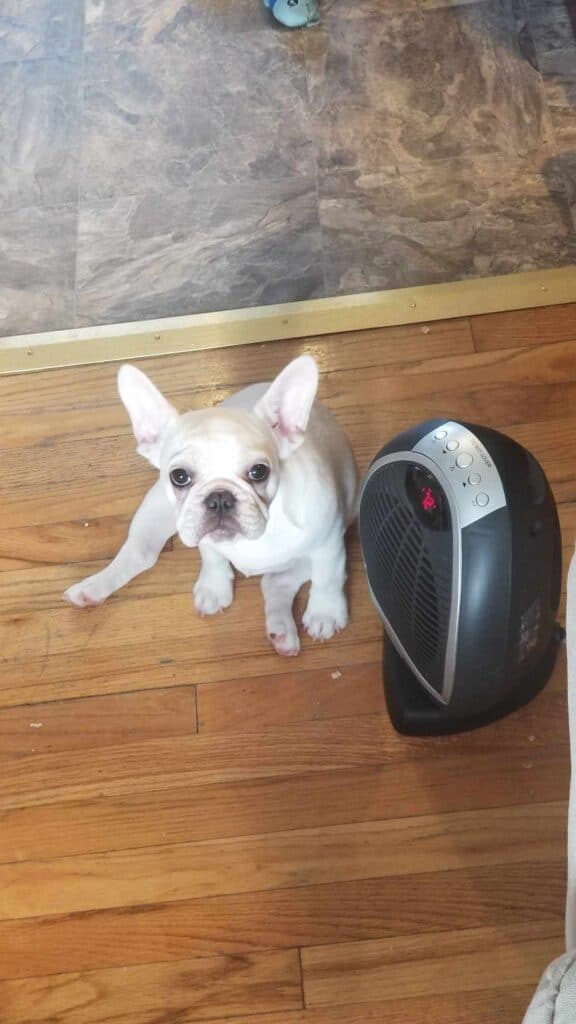
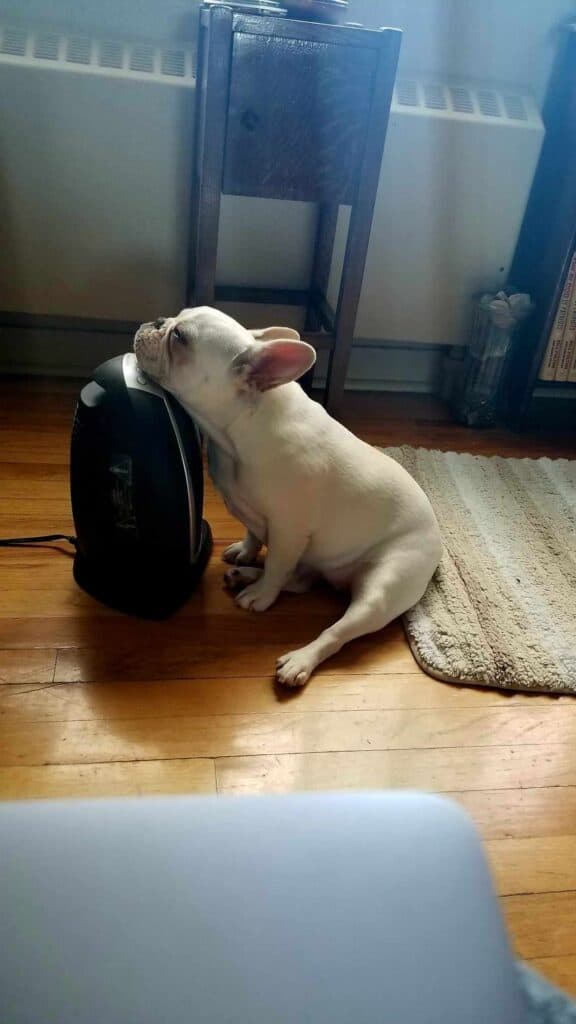
Sweaters
Dog sweaters. Some people love them, some people hate them. But the truth is, many frenchies actually like wearing them in the chilly winter months. Helga will actually stand by the drawer where I keep her sweaters when she wants one! There are so many types and styles to choose from. The only thing I’d say, is be sure to measure your dog properly, order the right size, and decide if you’ll need a little hole in the back for a harness clip, or whether you’ll put the harness over the sweater.

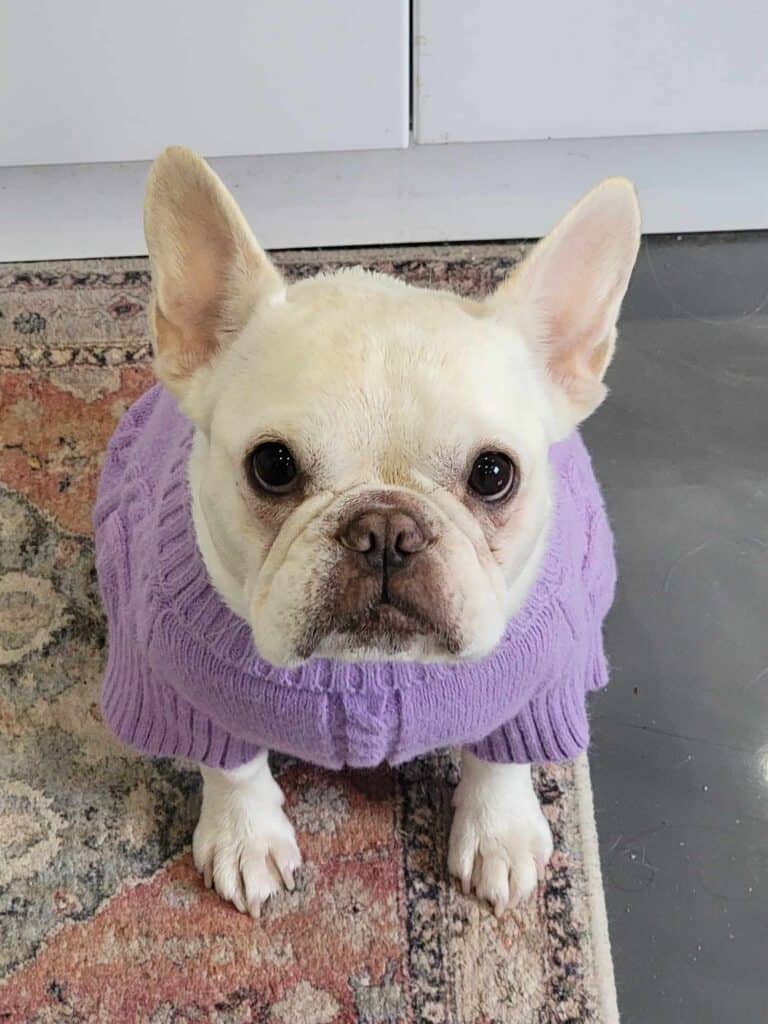
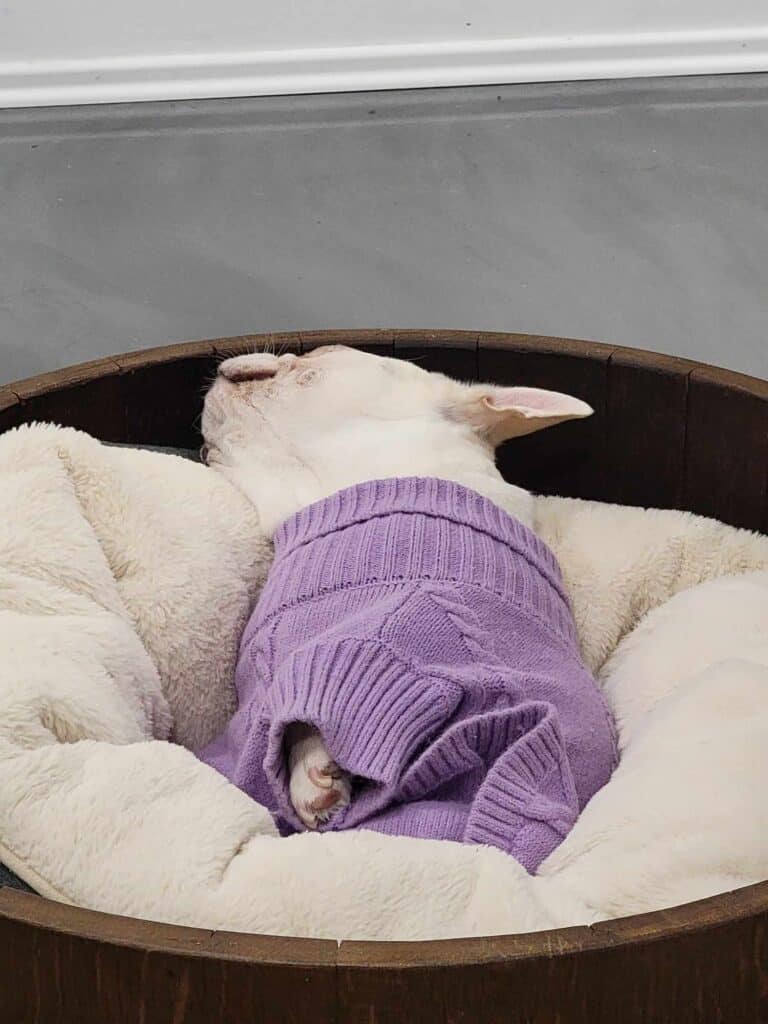
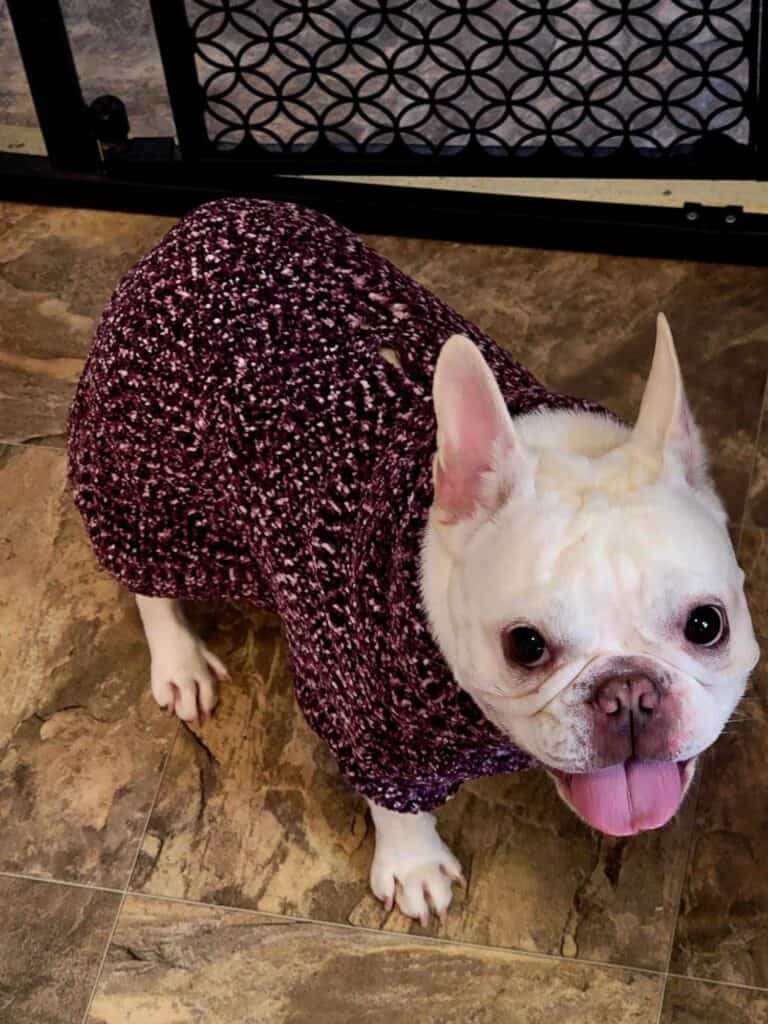
Pajamas
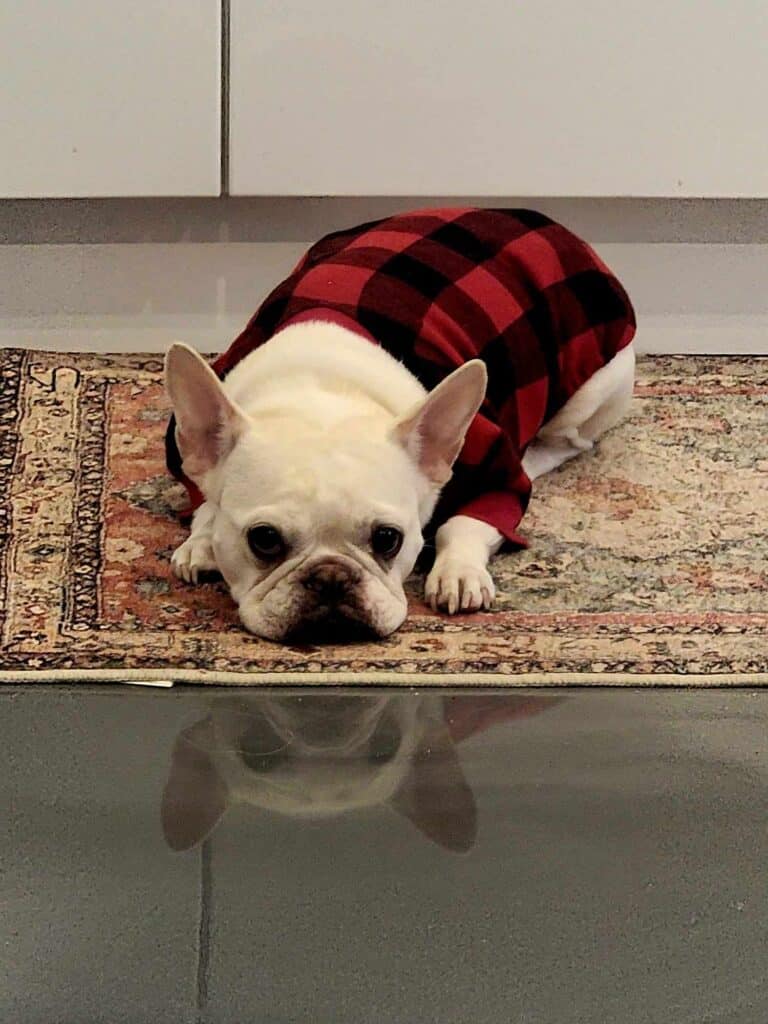
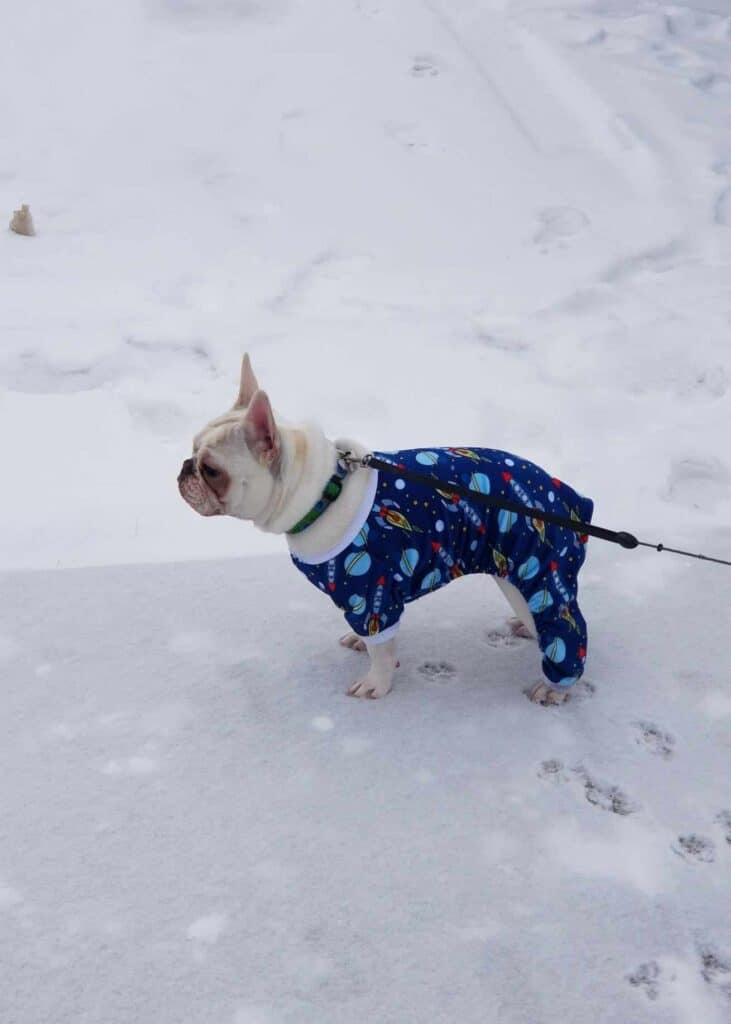


Don’t judge. Just like you sometimes like a nice warm pair of pajamas on a chilly winter’s night, so do many frenchies! In Alaska, we even sometimes put her in PJs to come check the mail or other short activities.
Coats
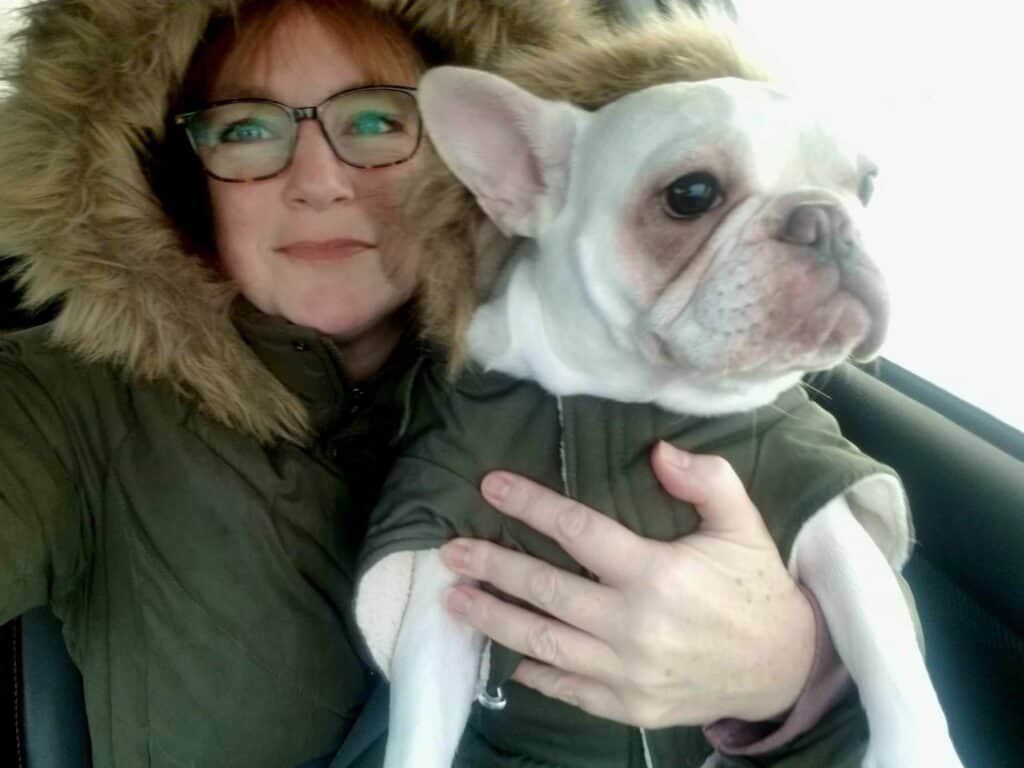
When it’s super cold and you’re outside, definitely have a coat for your frenchie. For coats, be sure that they come with a reinforced hole on the back so the harness clip can fit through it. It’s awkward, and sometimes impossible to put a harness on over a thicker padded coat.
And I also always look for coats that show a frenchie as the model so you can see how they fit on that body type.
Boots
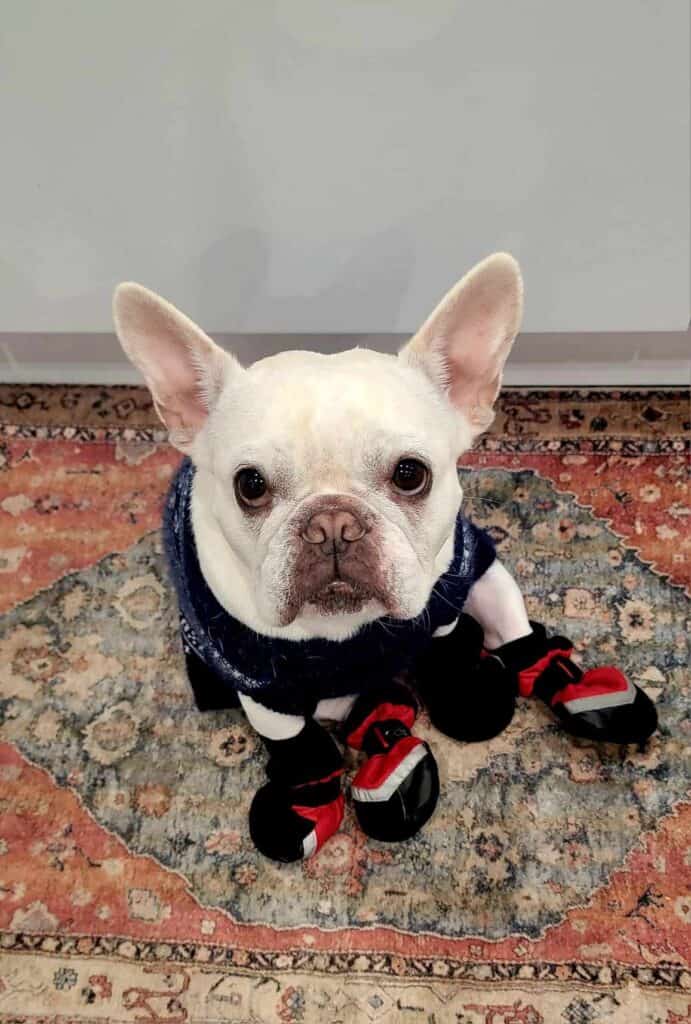
Boots are either for hard-core cold, if your frenchie is running the Iditarod (not recommended!), or if your dog gets little balls of ice on the fur between their toes which can be painful and cause injury.
Helga does not like wearing boots at all. We did manage to get her boots that she couldn’t remove when it was sub-zero weather. I think it was at this point we decided we were really glad she could use a litter box! She was a sport and posed for this pic, but as you can tell she wasn’t happy about it.
Hand Warmers
I know what you’re thinking. Dogs don’t have hands. This is true, but this is a great safety item to have, not only for dogs, but also for humans. Keep a couple with your dogs travel gear, your travel gear, and in your car. The heat these little packets put out can be enough to stave off frostbite on fingers, toes, and paws when the mercury plunges. You can put one inside your dog’s carrier or crate and let it do its thing. It will raise the temperature in the surrounding area and your dog can lay on it if they want to.
Lighting and Reflectors
With cold often comes dark. Be very sure that you and your dog (especially if they are dark colored or wearing a dark coat) are very visible to any on or off-road vehicles in the area. That means reflective everything, reflector tape on coats and leashes, light up collars, high powered flashlights, or anything that makes you very visible. Choose things that that are easy, and work for you.
First Aid Kit
It’s always smart to have a basic first aid kit that covers simple wound care when traveling with your dog. Unfamiliar trail hazards, broken branches, broken glass and many other dangers could put you in a tough spot if you’re unprepared. If you don’t want to assemble the parts yourself, you can get a pre-assembled travel-sized first aid kit to cover the basics.
Here’s what you should get if you want to pack your own first aid kit:
- Gauze pads
- Roll of gauze
- Adhesive tape that you can tear (or with a small pair of scissors)
- Saline solution and a plastic syringe (to clean wounds, or flush eyes)
- Latex gloves
- A small towel or piece of cloth
- The phone number and address of your primary vet, and the emergency clinic closest to where you will be.
You can pack all this up in a gallon-sized Ziploc or other small zip up bag.
Here’s a good dog first aid kit list that breaks it down even further.
For winter travel, I’d also suggest taking that basic list and adding:
- Travel-sized paw and nose balm
- A couple hand warmers and
- An emergency mylar thermal blanket (one of those super-thin foil ones to retain body heat).
Traveling with a Frenchie in the Cold: Tips

24-Hour Emergency Vet Clinic
Before you arrive at your destination, make sure you look to see where the nearest emergency clinics are, and find at least one that is open 24 hours. Enter this information on your phone so you can find it easily. You probably won’t need it, but this is good information to have at the ready if you do!
The best way to treat hypothermia is to prevent it in the first place.
🚶♀️Consider the length of your walks. For temperatures in the high 20s F (-2 C) your frenchie should be able to be outside for up to an hour if they are moving and if they are dry and it’s not snowing. If it’s snowing, raining, sleeting, or if temperatures get lower than that, keep a close eye on your frenchie and limit walks to half an hour.
🧊 Avoid Extreme Temperatures: Plan your dog-friendly excursions during warmer parts of the day, like mid to late afternoon.
⚠️ Listen to your frenchie: If you pick up any signs of distress or that they are cold, act right away. If they refuse to continue on, look at you as if asking for help, walk strangely or pick their paws up off the ground in an unusual way, start shivering, or begin to whine or make other sounds, it’s time to stop.
Don’t walk too far from home. If your frenchie is cold, you may end up carrying them or putting them under your coat, so don’t be too far away from a place to warm up.
Choose a clear path. Rough crystalized icy paths, or salted roads or sidewalks can be tough on sensitive paw pads.
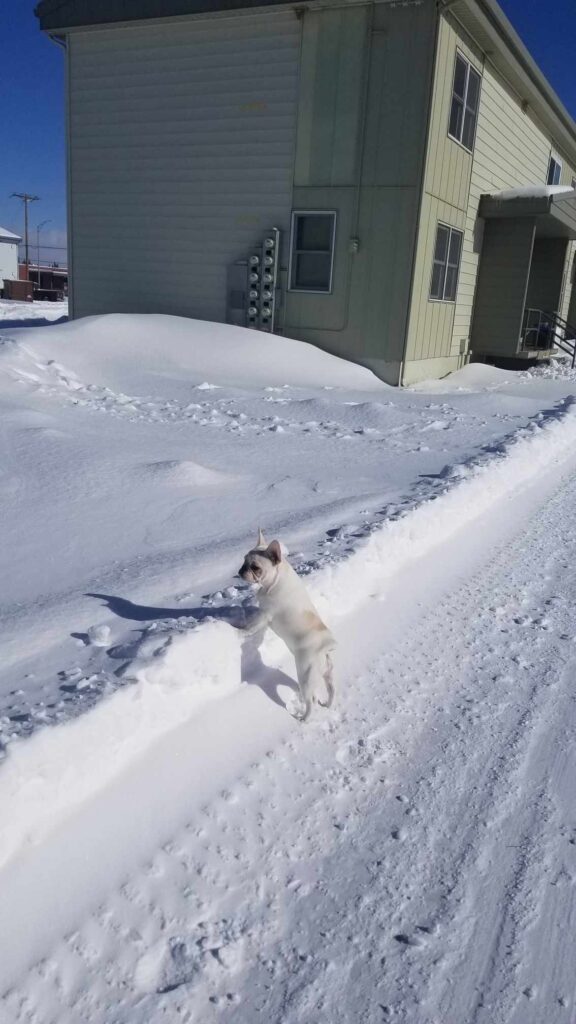
❄️ Don’t Eat the Snow! In addition to all the reasons we’ve been taught, there can be chemicals, ice melt, and other things in snow that we don’t want our dogs to ingest. It also will cool their core temperature, which is something we don’t want to happen.
💦 Keep Your Dog Hydrated: Ensure your dog always has access to plenty of fresh water at all times. Carry a portable water bottle and bowl for on-the-go hydration, and be sure the water isn’t ice cold. Carry it in an inside coat pocket next to you if you are outside.
🚫 Limit Exercise: While exercise is important for humans and dogs, you should avoid prolonged times outside if the weather is very cold. Opt for shorter, more frequent walks, a quick zoomie session in the snow, or let them enjoy being a snuggy warm couch potato.
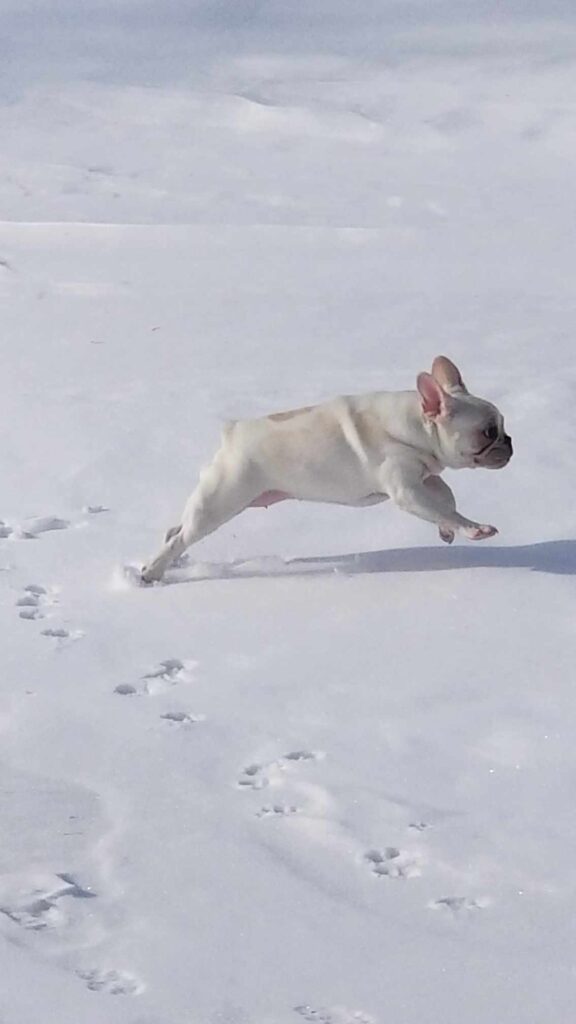
🔥 Use Warming Products: All the products above in the Cold Weather Essentials section will help regulate your Frenchie’s body temperature. If it’s cold, you don’t have to wait for them to really start feeling it to use these methods.
🚨 Recognizing and Treating Hypothermia
Anyone who owns a dog (especially one that is prone to chilling) should know the signs of hypothermia and be ready to react accordingly.
Signs of Hypothermia: Look for symptoms such as: breathing that is very rapid or very slow; shivering; cold limbs; hair standing on end; lethargy; confusion or disorientation; and pale gums, nose, or ears.
Immediate Action: If your Frenchie shows signs of serious hypothermia, get them medical treatment as soon as possible at your regular vet, a vet where you are traveling, or an emergency clinic.
At Home: On your way to seek assistance you can help your dog by wrapping them in warm blankets (out of the dryer is great), snuggling with them, placing a hot water bottle wrapped in a towel on their belly, and keeping them out of the cold.
Don’t ever put them in a warm bath because the rapid change in temperature can cause shock!
When to Reconsider Traveling with a Frenchie
Extreme Cold and Destination with Unreliable Heat: If the forecast predicts exceptionally cold or dangerous temperatures, or windy blizzard conditions, it may be best to postpone your trip. While traveling you can’t always control the environment. Power outages that kill heating and electricity, a car break down or accident, a delay that leaves you sitting on the tarmac… All these situations and many more could mean you find yourself in an unintended situation that is unsafe for your dog.
Your Dog’s Health: If your Frenchie is pregnant, or if they have any underlying health problems, you should always consult with your veterinarian before traveling.
Have Fun Traveling with Your French Bulldog!
With proper planning and precautions, traveling with a frenchie can be a wonderful experience for both you and your dog. We’ve created so many fun memories with Helga, and had peace of mind without worrying about finding a boarding facility, and knowing she wasn’t missing us.
By following these cold weather tips and prioritizing your dog’s safety, you can give your dog the opportunity to experience new things while building confidence and resilience! Being aware of the risks of traveling with a frenchie, being prepared for them, and being a responsible caretaker for your frenchie will help ensure a smooth, fun, and enjoyable journey. Enjoy creating those memories!
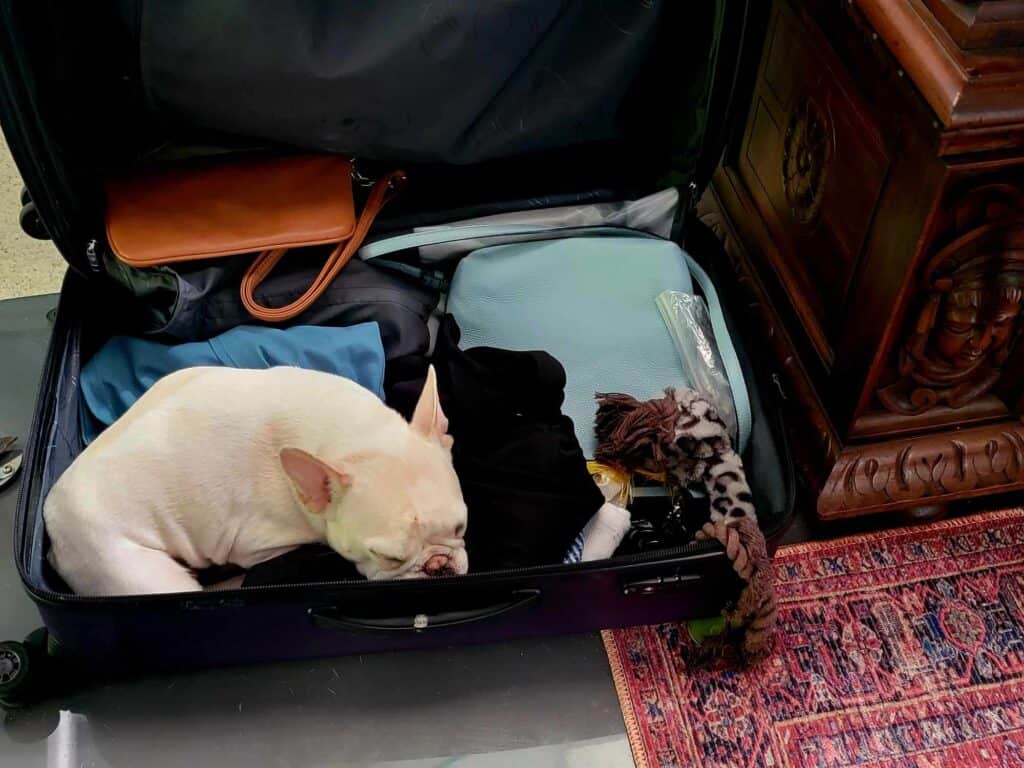
Related posts:
- How to Fly With Your Dog In Cabin – Top Tips
- Can You Buy Your Dog a Seat on a Plane? These 10 Airlines Say Yes!
- European Airlines That Allow Dogs in Cabin: Your Ultimate Guide
- Can French Bulldogs Fly? Your Ultimate Guide to Safe Frenchie Travel
- Flying Alaska Airlines with a Dog in Cabin – Your Comprehensive Guide
- Flying Volotea Airlines With a Pet in Cabin – Your Comprehensive Guide
- Flying With a French Bulldog on Delta Airlines
- Flying With a French Bulldog on Southwest – Your Ultimate Guide for Success
- Epic 16 Day Italy Road Trip With Your Dog!
- Staying With Your Dog in a Hotel – Top Tips!
Subscribe to get the latest dog-friendly travel tips, and follow our European travels!
